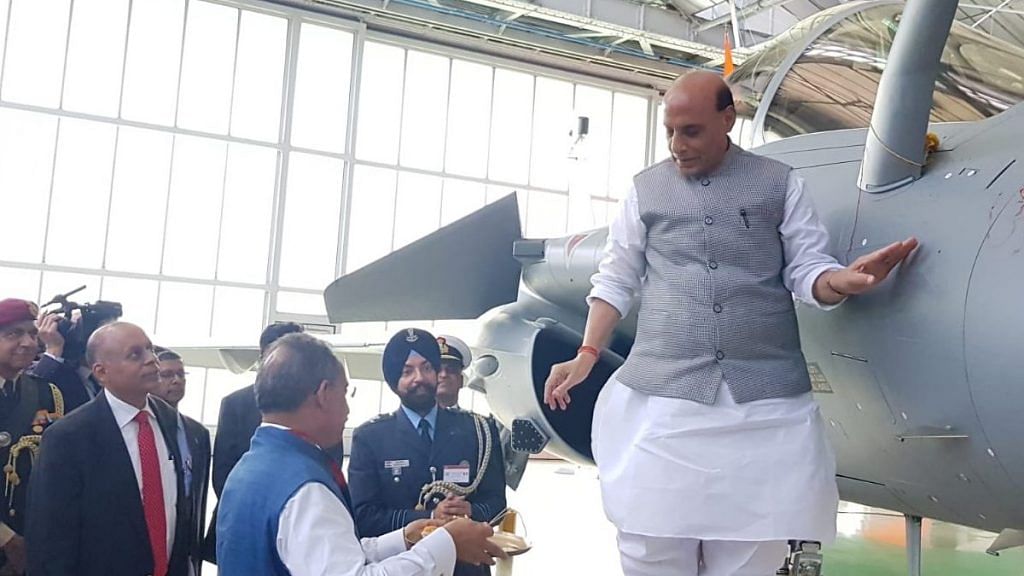The brouhaha this week over Defence Minister Rajnath Singh placing a coconut and drawing an ‘Om’ during the shastra puja of the first Rafale jet in France was unnecessary – politically and culturally. Not because I believe in religious rituals. I don’t. But it was unnecessary because millions of Indians believe in it. It is technically right to dismiss it as obscurantist and superstitious when a top official does it. But it is politically suicidal to say so these days.
Critics of the BJP must understand that Rajnath Singh was playing Everyman for devout Hindus this week. And the criticism of it only strengthened his base.
When Rajnath Singh drew the red Om on the Rafale jet, it was an extension of an image familiar to millions of Hindu homes across India where the dad-figures did the same. It was in sync with the Om so many neighbourhood grocery store owners write on top of every bill, and with people who drive their new cars first to the temple for blessings.
The Om-on-the-Rafale was actually the stuff of picture-postcard Incredible India. It was what poet Ashok Vajpeyi said many years ago at an event at the National Museum in Delhi: “There is a simultaneity to the way India lives – we live in several centuries at the same time.” It is what Indians take pride in – that they live in the 21st century, but follow ancient unbroken Hindu traditions. It is what the Western world finds ‘exotic’, ‘colourful’ and ‘fascinating’ about Indians.
But aggressive political Hinduism in India is so ripe today that smugly superior Indian atheists and Euro-style liberals (like myself) can no longer afford to be seen as being contemptuous of religion in public sphere. They don’t have to accept religion – they just have to make peace with the extreme prevalence of religiosity among Indians and the pujas before ISRO launches so that missions get ‘godspeed’. There will never be, and never was, a scrupulous church-state separation in India.
Also read: Why India of today looks more like Pakistan, Saudi Arabia or Israel
Sacrificing rationality to politics
It wasn’t just the memes, tweets and political cartoons that called out the Indian celebration of superstition in France, even politicians did. But cartoonists, meme-makers and Twitter stars are not in the business of fighting and winning elections. Politicians are. It is politically myopic for Congress party’s Mallikarjun Kharge and Sanjay Dikshit to jump in calling it a “tamasha” and saying Vijayadashami and the Rafale aircraft “don’t match”. Or for the NCP’s Sharad Pawar to compare the Rafale fighter jet to a “new truck”.
Politicians routinely endorse religious events and symbols. Sonia Gandhi wears the Hindu red thread around her wrist almost all the time. Others routinely check rahu and ketu schedules before swearing-ins and cabinet formations.
The Om-on-the-Rafale is only the most recent image in this series. Almost every prime minister has visited the Tirupati temple, attended Iftar or worn a Sikh turban, held a kirpan or shot an arrow at a Raavan effigy. Even liberal politicians like Congress MP Shashi Tharoor had to bow to Sabarimala devotees and give up on gender rights. The Ayodhya matter has killed so many people in the last three decades just because it is impossible to win an argument when it comes to people’s blind faith. Religious rituals may appear irrational to some, but many people in this country can kill and die for the sake of their irrationality.
Also read: World already accepts India as Hindu Rashtra, for its principle of unity in diversity
The worshippers
Let me recount an incident from 2001. India’s Ministry of External Affairs had organised a dinner for the foreign media at a five-star hotel in Delhi. I was working with The Washington Post back then. The ministry spokeswoman asked a newly arrived American journalist how she found India so far.
“I am surprised by how immensely religious Indians are,” the journalist replied.
The spokeswoman looked visibly shocked, offended and uncomfortable. “Really? Religious? Indians are not that religious. Are you sure you are not talking about Pakistanis?”
“No, I meant Indians are religious,” the journalist replied.
This exchange has stayed with me. An English-educated peripatetic diplomat either didn’t think that Indians are very religious or didn’t like the image of Indians as being very religious.
And yet it was just six years before this exchange that almost all of India had queued up outside temples to feed milk to Ganesha idols.
Also read: How Indian secularism could still be saved
Theory of everything
Now, the Ganesha-drinking-milk is my Theory of Everything to understand contemporary India. It didn’t happen a century ago. It wasn’t several generations ago. It happened just over two decades ago. The same set of people are still here – working, voting and forwarding WhatsApp messages.
Why are people voting for the BJP even though unemployment is high? Why are people saying lynching incidents aren’t a matter of concern even though it is seeing an alarming rise? Why are intelligent people willing to believe blatantly false WhatsApp forwards? Why do people still believe that the Nehru-Gandhi family can rescue the Congress party despite evidence to the contrary?
Because people are prisoners of blind faith and do not like rational arguments when it comes to their core beliefs. People from our families and neighbourhoods believed Ganesha idols were drinking milk not too long ago, after all. It is the Theory of Everything.
This is not to say people are inherently stupid. But the willing suspension of disbelief is a strong urge. And belief has always moved more boulders and set the EVMs ringing.
Even the murdered atheist Narendra Dhabolkar had to concede that one person’s superstition is another person’s devout faith.
